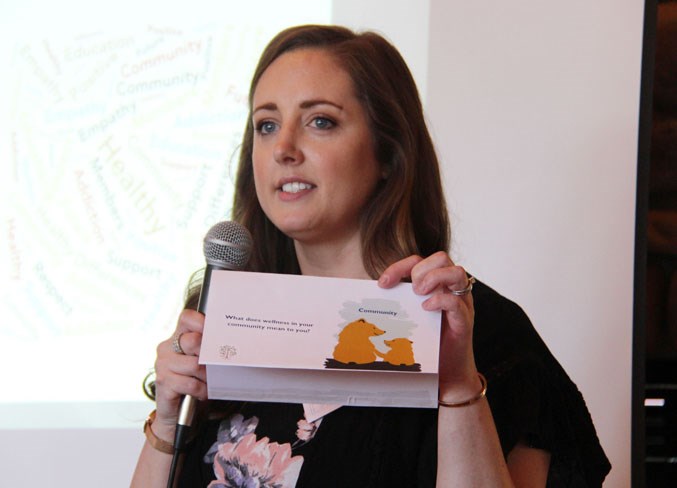Bonnyville is one step closer to becoming a healthy community.
The public was invited to join the Bonnyville Wellness Coalition in their journey to creating a healthier region, during a luncheon at the Shaw House on Thursday, May 16.
“The more people we have engaged at the municipal level, healthcare level, all sectors really, the more we’re able to do in the community. When we have that buy-in from everyone, we’re going to be able to push through initiatives,” expressed Sarah Cole, Alberta Health Services (AHS) promotion facilitator.
Part of their efforts include signing up for the Alberta Healthy Communities Initiative.
“This isn’t a project or program. It’s a tried and true approach to creating different ways of working together that supports communities in finding their own pathways to health and wellness,” explained community health facilitator Shana Young. “Our hope is that we can explore opportunities to collaborate, support, and build a healthier Bonnyville.”
The approach has someone from the Alberta Healthy Communities team working with the coalition to identify the area’s strengths and weaknesses when it comes to health and wellness.
Their ultimate goal is to decrease chronic disease and cancer across the province by encouraging communities like Bonnyville to consider their overall health.
“We’re changing the question from ‘how do we promote healthy behaviour in individuals?’ to ‘how can we create a healthy community environment that supports healthy choices?’” explained Young.
Working alongside the community, Young explained how by using research and community facilitation, they “connect the community, build relationships, and leverage the strengths that you already have. We want to build a team that has representation from five different sectors.”
This was one of the goals of the luncheon. The coalition was hoping to spark an interest in the public, such as municipal leaders, healthcare workers, those in education, and the community at large, to get involved with the program.
Young noted the reason they focus on changing things such as policies, habits, and environments, is because healthy eating, physical activity, and overall wellness have been directly linked to chronic illness, disease, and even cancer.
”We know the risk factors of physical inactivity, unhealthy eating, tobacco use, and alcohol consumption all increase our risk and rates of cancer and other chronic diseases,” she stressed. “These are some of the focus areas that we look at when we assess the community environment.”
She continued, “We know that the choices people make are shaped by the choices that they have. We know that healthy places are designed to help improve the quality of life for all, where every person is free to make choices in a variety of healthy, available, accessible, and affordable options.”
Even though people don’t have control over genetic make-up, age, and risk of illness based on aging, Young emphasized the importance of focusing on what you can manage.
“We do have control over some of our individual lifestyle factors and choices. When we take action on our community environment and make those healthy choices easier, it’s easier for people to choose those options.”
St. Paul and Cold Lake were among some of the municipalities who have already taken part in the initiative. Through the program, Cold Lake created the Healthy Choices Count Coalition, in addition to a UV protection campaign, the installation of three greenhouses, and the purchase of tower gardens.
The event gave local councillors, healthcare professionals, and the general public an opportunity to have their say, by sticking their comments on one of the posters around the room.
The coalition wanted to know what inspires them to be healthy, what is being done well in the community to promote health and wellness, and how they define wellness.
Stephen Sparks attended in hopes of learning more about what’s in store when it comes to collaborating healthcare services.
He believes physical, psychological, and spiritual wellbeing are interconnected.
“I want to know if we’re going to seriously establish something in the community, some kind of program, that will identify those areas of need and to help better coordinate how those needs can be best met,” he expressed.
Shavona Belyk, who attended the event on behalf of the Dr. Margaret Savage Crisis Centre, is a member of the coalition.
She explained how feedback and ideas like Sparks’ was welcomed and encouraged.
“This is where they live, this is where their community starts, is with them and their families... This is all about them, not just about one group, it involves everybody,” she said, adding they’re hoping to inspire a few attendees to join the coalition.
“We’re trying to recruit more members of the community and form different agencies to gather more resources so we can have a community that has more wellness. We’re trying to look for different ideas to bring in. We’ve been doing this for over a year now, just to try and get more people involved in the community so that we can make it a better place to live... I think we’re trying to get more involvement in the community, to see what people actually want. We have our ideas, but we want to know of more things that we’re not thinking about or haven’t thought of yet, just to try and get more involvement altogether.”



